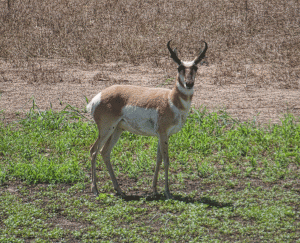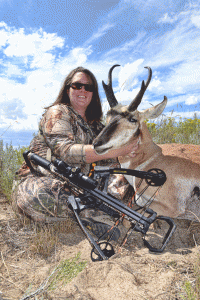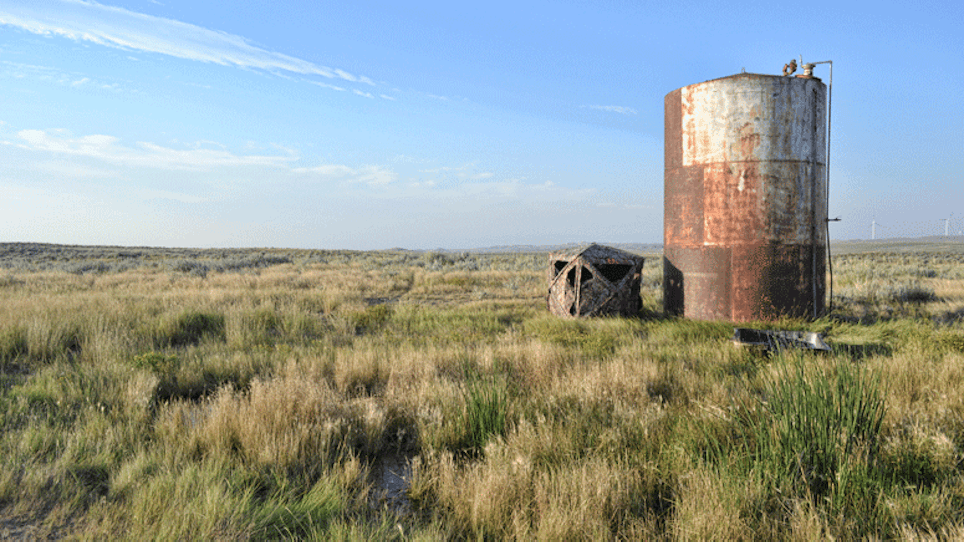“The fork of his horns should start above the ears,” a friend told me. “That’s the quickest way to field-judge a pronghorn.”
I had no idea what I was doing, but I was excited, and unbridled enthusiasm will take you a long way. I was going to hunt pronghorn.
Months before, Aaron McCaleb of Source Outdoors had invited me on a pronghorn hunt in Wyoming to test out one of Barnett Crossbows’ newer models, the BC Raptor Reverse. Pronghorn had been at the top of my bucket list for years, so I accepted Aaron’s invitation and started reading up on crossbows and pronghorns.
I already had one crossbow harvest under my belt — a small whitetail buck I’d killed more than a decade ago. It was the first big-game animal I’d ever taken, and frankly, if it hadn’t been for that crossbow hunt, I don’t know if I’d be a hunter today. I moved on to rifles after that, but kept that old crossbow around and shot it on the range occasionally. It was cumbersome and front-heavy, but it had done the job and was simple enough to use with a little practice. I figured I knew enough about crossbows to handle a new one comfortably on the pronghorn hunt.
Next, I wanted to learn what I could about pronghorn before I headed out to hunt them. I found out what Western hunters already know: Pronghorn are native to North America, and though often called “antelope,” they are not true antelope at all. They’re a unique species unto themselves, the only surviving member of the family Antilocapridae, more closely related to giraffes than to actual antelopes. To an Eastern hunter, they seem the epitome of The West. It’s commonly said that there are more pronghorns in Wyoming than there are people. Whether that’s true or not, I sure liked the way it sounded.
The biology is interesting, but what I really needed to know was how to hunt these handsome animals. They’re similar enough in size and shape to our smallish Southern whitetails that I knew shot placement wasn’t going to be a problem. Aaron had let me know that we’d be hunting over waterholes from a blind. Simple enough, though I wondered how maneuverable a bulky crossbow was going to be in the confines of a dark blind.
As for the meat, I got conflicting reports. Most of the hunters I knew reported that pronghorn meat was their favorite big-game meat — rich and sweet and delicious. But a handful of friends who had been served antelope meat that someone else had shot swore it was musky and tasted too strongly of sage. Who to believe? I chalked it up to the same thing that makes a difference in most any game meat — how it was handled and dressed in the field.
So I knew how I’d be hunting. I knew where to place my shot, and I knew the meat should be good if I handled it properly. What I still needed to know was how to decide which buck to shoot.
I’m a firm believer that a trophy is a trophy if the hunter is happy with it, no matter the size or score. There would be no holding out for a monster — an average-sized pronghorn would make me more than happy — but I also didn’t want to be “That Girl” in camp who shot a too-small buck and was the butt of jokes for the rest of the trip.
“It’s not like guided whitetail hunting,” my friend Randy Burtis texted me. He’s an experienced Western bowhunter and a guide at Table Mountain Outfitters, where I’d be hunting. “There are no fines for shooting the ‘wrong one.’ Shoot any antelope that makes you happy.”
That made me feel a little better, but I needed a crash course in field-judging pronghorn. A poll of my Facebook friends (most of whom are hunters) left me with advice like “the horn should be more than twice the height of the ear” and “the base should be one and a half times the width of the eye,” but the one that stuck with me as being simple and quick was “if the prong starts above the ear, he’s good enough.”
I was as ready as I was going to get and bubbling over with eager anticipation.
I landed in Casper on August 14 and met up with fellow hunters Aaron, Bob, Will and Ben Rand with Plano/Synergy. It was hot, as we’d hoped, and we arrived at Table Mountain Outfitters’ bunkhouse near Glenrock early in the afternoon. Aaron had a selection of Barnett crossbows for us, and I snatched up a BC Raptor Reverse. I hadn’t shot a reverse-limb crossbow before, and it had a much slimmer profile than I expected. Crossbow technology has come a long way since my old 2003 model was built!
I took the BC Raptor Reverse out back to the archery range to get sighted-in. I had to shorten the cocking rope to fit me, but once that was done, cocking was a simple and straightforward process. We were shooting Bloodsport crossbow arrows with Grave Digger broadheads, which combine a fixed-blade head with two mechanical blades — the best of both worlds. A little range time had me dialed in and ready to roll.
Ben had brought us Halo rangefinders and Tenzing harnesses to try out, so I loaded my backpack and tried to fall asleep that night.
To my surprise, it was an hour after sunrise when we headed out. Table Mountain Outfitters owner Angie Denny drove me right up to the double blind and walked circles around the area, scoping things out before she left me with a “good luck, call me when you kill him!”
I surveyed the area. A tall water tank partially obscured the blind from any animals that might approach from the left. A solar panel behind the tank powered a pump that fed water into a makeshift plastic waterhole about 15 yards in front of the blind. It was a slick, low-maintenance setup that ensured water would always be there.
I settled into a folding chair, set up a video camera, unzipped enough windows to give me a decent view and propped up the fore-end of the Raptor Reverse on a bipod for support. I ranged the far side of the small waterhole and several sage bushes (there wasn’t much else) with the Halo. “Antelope can see forever,” Angie had warned me. “And they can see almost all around them — they have a really wide field of view. Sit in the back of the blind so you can stay hidden in the shadows, and try not to move.”
I sat back to watch the sage grouse. The wind picked up, buffeting my blind loudly and making me (and, I suspected, the antelope) a little nervous.
For no reason other than a hunch, I suspected animals would come in from the left. I was right. About 45 minutes into my sit, two young antelope walked in 20 yards out, casually confident and unafraid, and drank from the natural waterhole formed by the overflow from the plastic tub. They sauntered off, and a doe wandered in shortly afterward for a quick drink. At least I was seeing antelope — it was an encouraging sign.
It was about 10 in the morning when movement caught my eye coming from the left. My throat got tight and my heart got loud as my eyes went to the dark horns on his head. They pronged right at the top of his ears.
He was moving more cautiously than the others had, dipping his head but raising it again, and pausing every few steps to survey the area. When he settled down, lowered his head and committed to walking to the waterhole, I knew I had a second to compose myself and wrestle with the idea of whether he was a shooter or not. You know the thought process: He’s pretty average. There are much bigger bucks out here somewhere. It’s still morning and it’s only the first day. Do I want this to be over yet?
I decided to heed the age-old wisdom of never passing something on the first day that you’d be happy with on the last day, and I found him in the scope.
He was quartering toward me, head down to drink, but looking up every few seconds. Had he seen me? Surely not, or he’d be gone by now. He lifted his head and took a step to the left, as if to go back the way he’d come. One more step and I’d have the right angle through the smallest window in the blind, if he didn’t spook and take off.
He didn’t spook. Whether he was done drinking and was ready to leave, or was just meandering around to a different spot on the edge of the waterhole, I’ll never know, because an arrow zipped through just behind his shoulder and changed his plans. His back legs kicked out and he took off at warp speed, in the same direction he’d come from. I jumped out of the chair and stuck my head out the window to watch him, hoping to see him pile up. But his speed carried him out of my view around the water tank, and by the time I got out of the blind and ran around, he was out of sight. The arrow had blood on it, but I walked the area off and found only one drop of blood.
Oh, no.
Angie rolled up in the truck 30 minutes later with a cameraman, and we spent the next couple of hours poring over a 400-yard radius in the truck and on foot, barely noticing the temperature was approaching 100 degrees.
No sign. Glassing revealed nothing but sage and more sage. We were about to call in more reinforcements when Angie decided to check one little draw she thought we hadn’t covered thoroughly enough the first time around. Her intuition proved right, and relief flooded us all as the truck came over a hill and almost ran over a dead pronghorn sprawled in the middle of the trail.
After pictures and field-dressing, a quick autopsy revealed that the shot had been perfect — it had taken out both lungs, but he was so fast he’d managed to run more than 300 yards from the blind before he piled up. “It’s weird,” one of my fellow hunters told me later as I was relaying the story, “but critters hit with arrows just do funny things sometimes.”
Must-Have Pronghorn Gear
For maneuvering in a blind (read: squirming around to see out of the window when the shot presents itself), you want a slim crossbow that isn’t too wide or too heavy. The BC Raptor Reverse is only 11 inches wide when cocked, and I found it very easy to handle in a tight space. Your broadhead of choice will work fine, but our hunting party had great success with the Grave Digger fixed- blade/mechanical combo.
You need a chair to sit in that allows you to see out the windows. A bipod or tripod is recommended if you don’t want to shoot off-hand, because bracing your elbow on your knee to support the crossbow will probably be out of the question — you won’t be high enough to shoot out of the windows.
Table Mountain Outfitters hauls a small square of remnant carpet to the blind and lays it on the ground before you bring in your chair. While it certainly isn’t necessary, it’s a great creature comfort that keeps dust to a minimum and gives you a clean place to set down your gear.
This early in the season, it’s almost guaranteed to be hot. A small cooler full of ice, cold drinks, snacks and a lunch (you’re going to sit all day if you have to, right?) is a lifesaver.
Bugs might or might not be a factor depending on where you’re at, but don’t find out the hard way. Pack a Thermacell or bug spray so you won’t tip off every pronghorn in the county by swatting mosquitos all day.
Pronghorns live in big country, and depending on your setup, they could approach from a long way out. You’ll want binos for field-judging from afar, and don’t for






